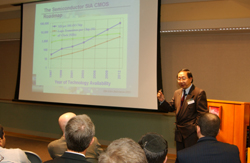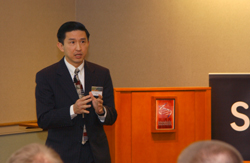|
Oct. 4, 2002--The Delaware Biotechnology Institute and Silicon Graphics Inc. (SGI) of Mountain View, Calif., were joint hosts for a well-attended executive summit on “Delivering Technology Leadership for Life Sciences” held Thursday, Oct. 3.
The summit featured a distinguished roster of researchers from leading pharmaceutical companies, bioinformatics organizations and universities, including the University of Delaware, and was attended by more than 100.
Speakers looked at trends and challenges in high-performance computing and the impact of visualization on life and chemical science research as it relates to understanding the nature of disease, drug discovery and bioterrorism.
The event provided an opportunity for industry researchers and leaders to share information and to tour DBI’s new Visualization Center, located on the University of Delaware campus.
“This is a rare opportunity to bring together top researchers from private industry, academia and the public sector in a real-world venue that showcases the latest visualization technologies for accelerating life sciences research,” according to Dan Stevens, SGI Life Sciences marketing manager. “As the industry enters into what could be termed a ‘post-genomic period’ involving ever-increasing high-performance computing and collaborative visualization needs, we hope that the summit’s technology demonstration and free exchange of ideas will enable all who attend to gain a new appreciation for available solutions that can meet the challenges facing the industry today.”
Karl Steiner, associate director of the Delaware Biotechnology Institute, opened the program with an overview of the state’s life sciences initiative that resulted in the formation of DBI. The goal is to establish Delaware as a center of life sciences research, he said, noting that the institute is located in the middle of the East Coast corridor that contains half of the nation’s top 20 biotechnology clusters.
Steiner said DBI has built on the University of Delaware’s strengths in agriculture, human health, computational biology, marine ecosystems and biomaterials. He noted that UD has created new minors in bioinformatics and computational biology.
 |
| Guang Gao |
Guang Gao, UD professor of electrical and computer engineering and director of DBI’s Center for Bioinformatics, and Eng Lim Goh, SGI senior vice president and chief technology officer, then discussed the role of high-performance computing in the life sciences.
“History has proved that high-end computing systems have enabled computations of unprecedented scale,” Gao said, adding this is important because life, and in particular human life, is so complex.
Gao said high-performance computing is necessary to carry bioinformatics to the next level, which is the use of data in predictive modeling and simulation, emulation and visualization.
SGI’s Gho discussed the latest work under way in the storage, retrieval and use of vast amounts of data such as are involved in the life sciences in visualization, which can translate information into two- and three-dimensional images.
Gho said that while storage of digital information is growing quickly, the speed with which that data can be recovered is not. As a result, SGI is working to “pack” storage into smaller units to shorten the wires and, in turn, speed the flow of information.
 |
| Eng Lim Gho |
Visualization will play an important part in the life sciences, Gho said, because collaboration is so important to the research. He discussed products such as bench projectors and large screen formats, data from which can be used by multiple scientists in a single laboratory or translated to distant computers.
Other speakers were
Robert Bruccoleri, research fellow in applied genomics at Bristol-Myers Squibb, who discussed “Delivering the Promise of Bioinformatics”;
Eliot Grigg, research associate in the Thayer School of Engineering at Dartmouth College, who discussed “Cybercare: Combining Healthcare and Computing Technology for Homeland Defense”;
Joe Cerro, head of bioinformatics for Bayer Pharmaceutical, who discussed “Chips and Choices: Informatics and Research Productivity”;
Jack Collins, manager of scientific computation and program development in the National Cancer Institute’s Advanced Biomedical Computing Center, who discussed “Bioinformatics and Knowledge: Converting Data to Knowledge”;
George Shields, professor and chair of chemistry at Hamilton College and director of the Molecular Education and Research Consortium in Undergraduate Computational Chemistry (MERCURY) program, who discussed the “Formation of MERCURY and Acquisition of High-Performance Computers to Support Research in Undergraduate Computational Chemistry across New York and New England”;
Russ Miller, director of the University of Buffalo’s Center for Computational Research, who discussed “The Buffalo Center of Excellence in Bioinformatics: Utilizing HPC and Visualization Technologies to Support University and Bio-Incubator Environments”; and
Anastasia Christianson, associate director of Enabling Science and Technology, Bioinformatics, for AstraZeneca Pharmaceuticals, who discussed “Bioinformatics in Drug Discovery.”
Article by Neil Thomas
Photos by Kathy Flickinger
|

